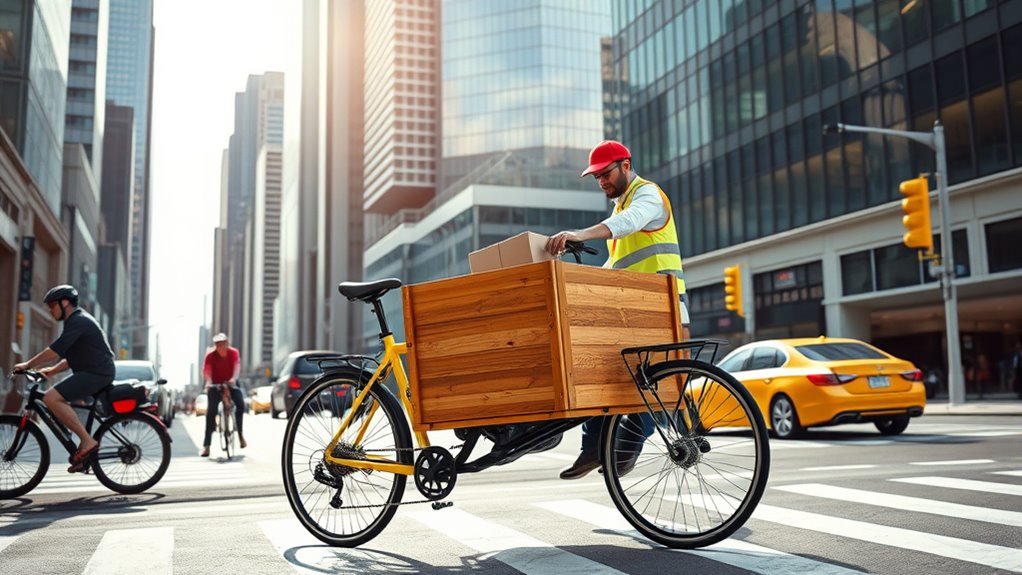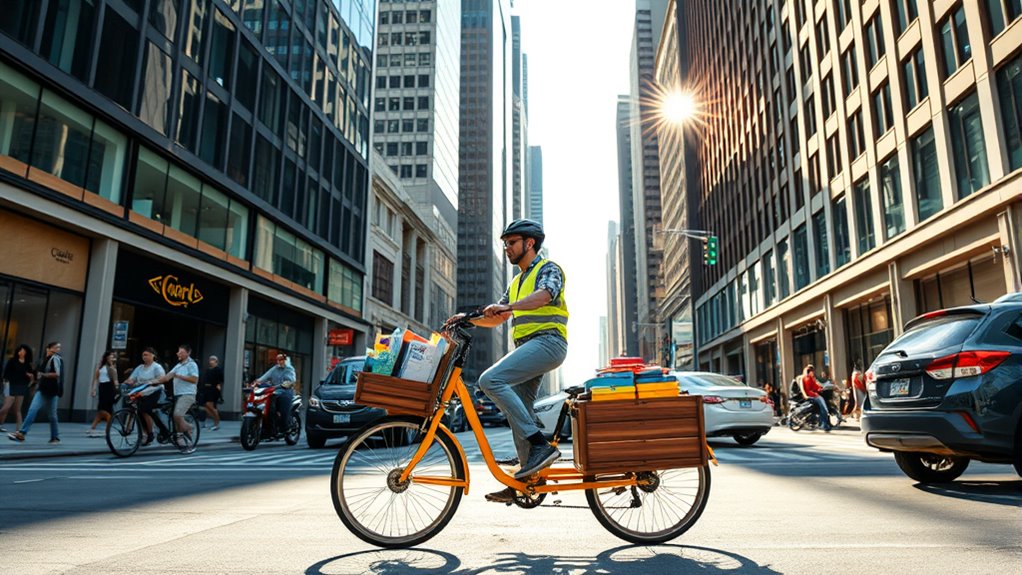Cargo bikes are transforming urban logistics by offering a sustainable, space-efficient way to deliver goods. With electric assist, they handle heavier loads and longer distances, making deliveries faster and more reliable in traffic-heavy areas. Their compact size helps navigate narrow streets and crowded neighborhoods, while infrastructure like bike lanes and loading zones makes using them easier and safer. If you want to discover how these bikes are shaping cleaner, more efficient cities, keep exploring their many benefits.
Key Takeaways
- Electric cargo bikes provide a clean, efficient, and cost-effective alternative for urban deliveries, reducing emissions and operational costs.
- Proper infrastructure such as dedicated bike lanes and loading zones enhances cargo bike adoption and delivery efficiency.
- Their compact design allows navigation through narrow streets and access to otherwise inaccessible destinations.
- Cargo bikes support sustainable urban logistics by lowering noise and air pollution, aligning with city climate goals.
- Space-efficient and versatile, cargo bikes help reduce congestion and optimize delivery operations in dense urban environments.

As cities become more congested and environmentally conscious, cargo bikes are emerging as a practical solution for urban logistics. You might find yourself steering through busy streets, trying to deliver packages efficiently while avoiding traffic jams and emissions. Electric cargo bikes are transforming how deliveries happen in city environments, offering a cleaner and more flexible alternative to traditional vehicles. With an electric motor, you gain the power needed to carry heavier loads over longer distances without exhausting yourself. This makes deliveries faster and more reliable, especially in areas where traffic congestion can slow down vans and trucks. Plus, electric cargo bikes are quiet, reducing noise pollution and contributing to a calmer city atmosphere.
Electric cargo bikes offer a clean, efficient, and flexible solution for urban deliveries amid traffic and pollution challenges.
However, to maximize the benefits of cargo bikes, cities need to invest in proper bike infrastructure. Well-designed bike lanes, dedicated loading zones, and secure parking spots make a significant difference. When bike infrastructure is in place, you don’t have to worry about sharing narrow streets with fast-moving cars or risking theft because of inadequate bike parking. Instead, you can focus on making timely deliveries, knowing that the environment is supportive of your mode of transport. Cities that prioritize bike infrastructure also make it easier for new businesses to adopt cargo bikes, encouraging a shift toward more sustainable logistics practices.
You’ll notice that electric cargo bikes are particularly effective in areas where space is limited. Narrow streets and crowded neighborhoods benefit from the compact size of these bikes, which can weave through traffic and reach destinations that might be inaccessible to larger vehicles. This agility helps reduce delivery times and operational costs, making it a smart choice for small businesses and large logistics companies alike. As more cities develop dedicated bike infrastructure, the integration of electric cargo bikes into the urban freight system becomes even more seamless. This evolution not only streamlines delivery operations but also promotes eco-friendly practices that benefit everyone.
Furthermore, electric cargo bikes can be adapted to different urban needs. From small deliveries within neighborhoods to bulkier loads for commercial use, these bikes are versatile. They also help cut down on carbon emissions, aligning with city goals to reduce pollution and meet climate targets. As you consider options for urban deliveries, recognizing the importance of supportive bike infrastructure and the advantages of electric cargo bikes can make a significant difference. They’re a practical, sustainable, and increasingly essential part of modern urban logistics, helping cities become cleaner, more efficient places to live and work. Additionally, understanding how space-efficient design plays a crucial role in urban logistics can help optimize operations and reduce congestion.
Frequently Asked Questions
What Are the Safety Regulations for Cargo Bike Use?
You should guarantee your cargo bike meets safety certifications and that you wear proper rider safety gear, like helmets and reflective clothing. Follow local traffic laws, use lights and signals, and regularly check your bike’s brakes and tires for safety. Staying visible and alert helps prevent accidents. By adhering to these safety regulations, you protect yourself and others, making urban cargo bike use safer and more efficient.
How Do Cargo Bikes Compare Cost-Wise to Traditional Delivery Vehicles?
Imagine you’re stepping into a time machine and discovering cargo bikes. They typically have lower purchase costs than traditional delivery vehicles, leading to significant cost savings over time. While the upfront investment might seem higher for some models, you’ll save on fuel, maintenance, and parking fees. Overall, cargo bikes offer an economical alternative, making your urban deliveries more affordable and eco-friendly, especially when compared to gas-guzzling trucks.
Are Cargo Bikes Suitable for All Weather Conditions?
You’re likely to find that cargo bikes aren’t suitable for all weather conditions. They have limited weather resilience, especially in heavy rain, snow, or extreme cold, which can impact safety and efficiency. Seasonal adaptation is necessary; you might need to use alternative transportation or protective gear during harsh weather. While they work well in mild, dry conditions, for year-round reliability, consider how weather impacts their practicality in your specific urban environment.
What Maintenance Is Required for Cargo Bikes?
Did you know that proper maintenance can extend your cargo bike’s lifespan by up to 30%? You should regularly check the bike frame durability to prevent cracks and guarantee safe rides. Battery maintenance is vital; keep it charged, clean terminals, and avoid extreme temperatures. Also, lubricate moving parts and inspect brakes frequently. Staying on top of maintenance keeps your cargo bike reliable, safe, and ready for your daily deliveries.
How Do Cargo Bikes Impact Urban Traffic Congestion?
You can substantially reduce urban congestion and improve traffic flow by using cargo bikes. As more people choose these eco-friendly alternatives, fewer cars clog city streets, easing congestion during peak hours. Cargo bikes navigate through traffic more easily, allowing quicker deliveries and commutes. This shift not only eases pressure on infrastructure but also promotes sustainable urban mobility, making your city more livable and efficient.
Conclusion
Imagine a busy city street where a cargo bike weaves effortlessly through traffic, like a needle through fabric. Just last month, a delivery company reported a 30% increase in efficiency after switching to cargo bikes. These bikes aren’t just vehicles—they’re the heartbeat of smarter, greener urban logistics. As cities grow more crowded, embracing cargo bikes is like giving urban life a gust of fresh air, making deliveries smoother and streets cleaner.
















